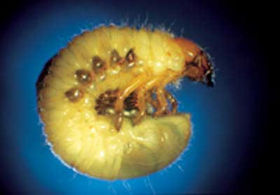Chafer Grubs
- Do you see yellowing, weak areas of grass where the roots have been damaged?
- Can the grass be easily pulled up, with little or no root growth?
- Is further damage being caused by birds and mammals, such as foxes and badgers, digging up the turf?
If the answer to these questions is yes, then your lawn may have been damaged by Chafer Grubs.
Chafer Grubs are the larvae of the Chafer Beetle. The larvae cause damage to lawns by feeding on the roots of grass plants. The adults emerge between the end of May and July depending on the weather conditions in spring. And lay their eggs into grassed areas. Larvae hatch about 2 weeks later and begin to feed on grass roots until late September when they move deeper into the soil where they pass the winter. When the larvae are small they do not cause much damage to grass unless they are in very high numbers, causing more damage as they grow bigger.
The grubs are about 18mm long and have a stout white body curved in a C shape, light brown heads, with three pairs of legs at the head end. They can be found in the soil under the loose turf.
Can I control it chemically?
Yes, they can be controlled using Bayer’s Provado when they are in larvae stage in June to July.

 Delivery
Delivery Basket
Basket Checkout
Checkout How will my items be
delivered?
How will my items be
delivered?
 How to keep my lawn
healthy?
How to keep my lawn
healthy?










